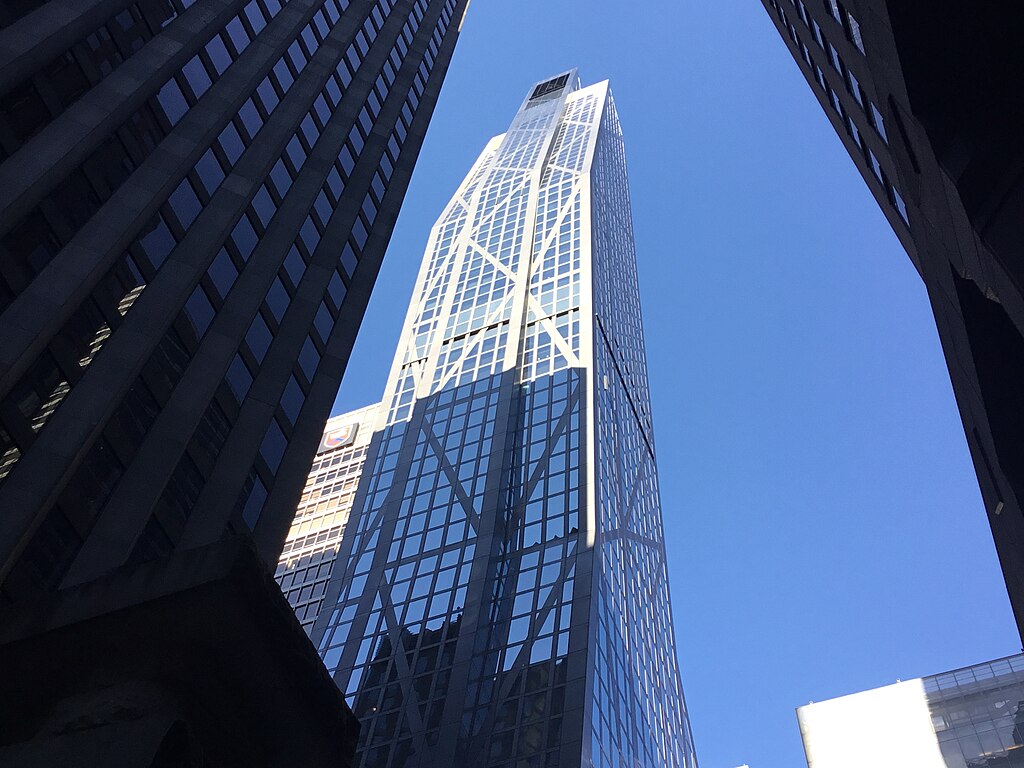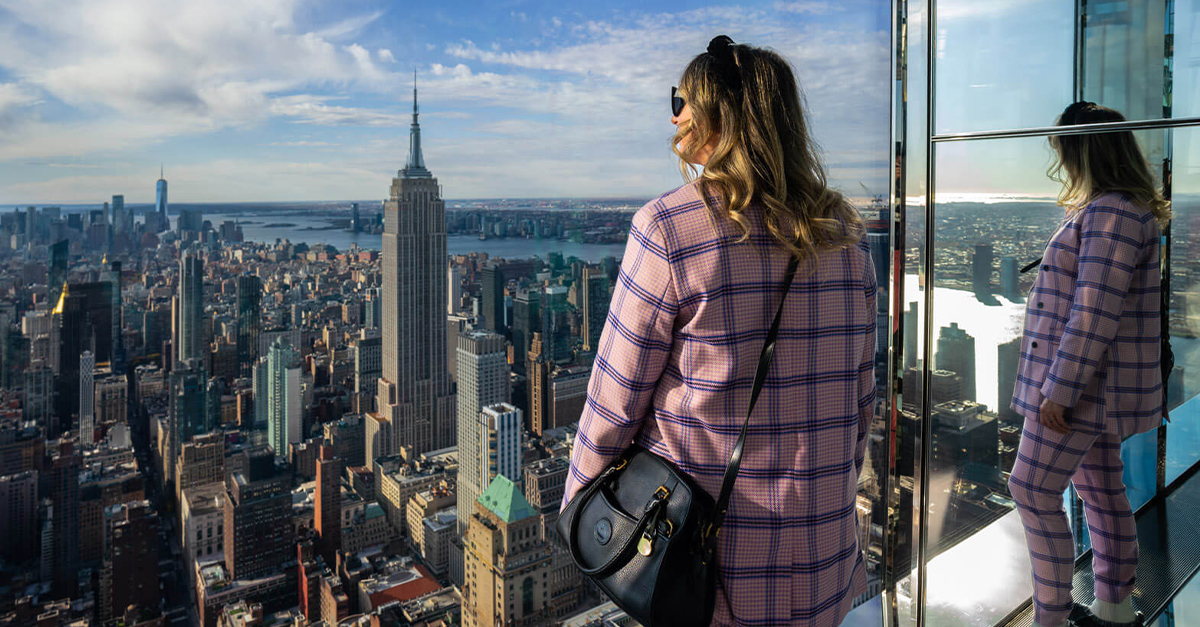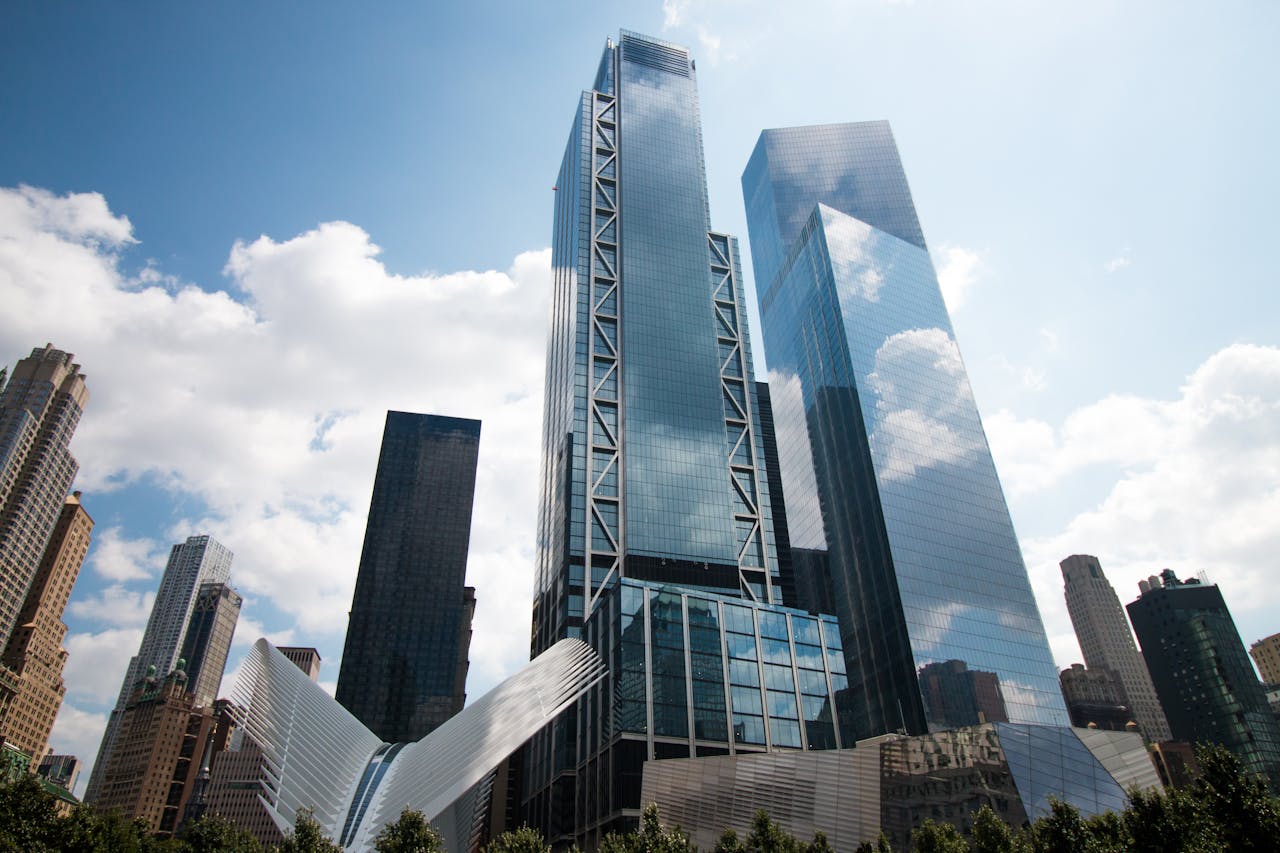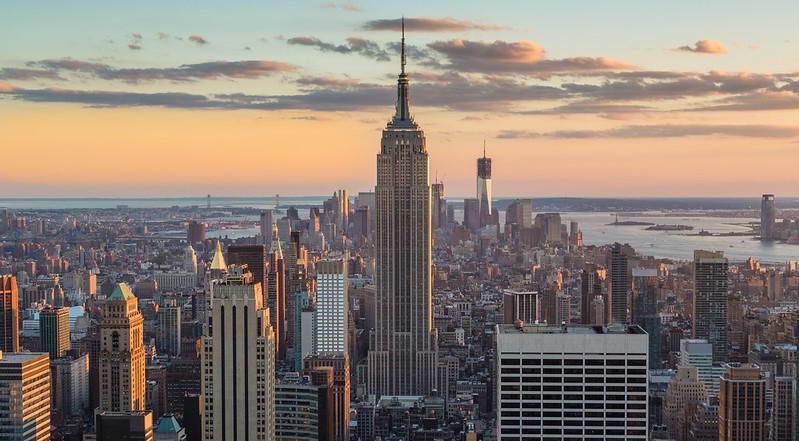View From The Top Floor
The 10-story Home Insurance Building in Chicago was the first building framed with structural steel. Since its completion in 1885, tall buildings have taken over the skylines of New York, Chicago, and many other US cities. And changing technology and economics have allowed skyscrapers to grow ever taller—27 of the structures on our list of America’s tallest buildings have been constructed since 2000.

220 Central Park South (Manhattan)
Height: 950 ft
This building is part of a wave of luxury apartment towers to appear along the south edge of Central Park in the 2010s. The high cost of land and construction, coupled with increased demand from very wealthy buyers makes this area of Manhattan some of the most expensive real estate on Earth. Single-unit sales at 220 Central Park South have been reported into the hundreds of millions of dollars.
 Jim.henderson, CC BY-SA 4.0, Wikimedia Commons
Jim.henderson, CC BY-SA 4.0, Wikimedia Commons
311 South Wacker Drive (Chicago)
Height: 961 ft
At the time of its completion in 1990, this office building in downtown Chicago was the tallest reinforced concrete building in the world. It is known for its two-story glass ceilinged lobby, and its roof structures that are lit in the evening, making it a prominent part of Chicago’s nighttime skyline.
Comcast Center (Philadelphia)
Height: 971 ft
The company headquarters of Comcast Cable, which occupies 89% of the building, this complex has several energy- and water-saving features. It was the tallest LEED-certified building in the US at the time of its completion in 2008.
One Chicago East Tower
Height: 974 ft
Completed in 2022, this mostly high-end residential complex consists of two separate towers joined by a commercial building offering a variety of amenities, including a fitness center and dog park.
 Jdldevelopment, CC BY-SA 4.0, Wikimedia Commons
Jdldevelopment, CC BY-SA 4.0, Wikimedia Commons
4 World Trade Center (Manhattan)
Height: 978 ft
The headquarters of the New York Port Authority, 4 World Trade Center was built throughout 2008–2013. Designed by the highly respected Fumihiko Maki, the building received praise for its stately, unassuming design that complements its taller neighbor at One World Trade Center.
50 Hudson Yards (Manhattan)
Height: 981 ft
Part of a massive redevelopment in Midtown Manhattan that took decades to bring about, 50 Hudson Yards is the fourth-biggest office building in Manhattan by leasable square footage (3 million). Its main tenant is the enormous BlackRock investment bank, occupying just under a third of that space.
 Dazzling4, CC BY-SA 4.0, Wikimedia Commons
Dazzling4, CC BY-SA 4.0, Wikimedia Commons
Wells Fargo Plaza (Houston)
Height: 992 ft
The second tallest building in Houston, Wells Fargo Plaza lost several windows to the fury of Hurricane Alicia in 1983. Interestingly, the building’s footprint has the shape of a dollar sign. The office tower has had a highly variable vacancy rate over the years, possibly due to the boom-and-bust nature of the oil-based Texas economy.
 Spacecaptain, CC BY-SA 3.0, Wikimedia Commons
Spacecaptain, CC BY-SA 3.0, Wikimedia Commons
Two Prudential Plaza (Chicago)
Height: 995 ft
Built to connect to a smaller Prudential building completed in 1955, this reinforced concrete office tower completed in 1990 received several awards for its structural engineering. With its pyramidal roof and chevron ledges, it’s considered an example of late postmodernism. It houses the Canadian Consulate General.
 Chris Rycroft, CC BY 2.0, Wikimedia Commons
Chris Rycroft, CC BY 2.0, Wikimedia Commons
1 Manhattan West
Height: 996 ft
The taller of a pair of towers built over the train tracks leading to nearby Penn Station, a major structural engineering effort was required to create the steel framework at the building’s base. The structure was completed in 2019, costing nearly $2 billion. Its biggest tenant is international law firm Skadden, Arps, Slate, Meagher & Flom, who occupy almost a third of the building’s 1.8 million square feet.
 Kidfly182, CC BY-SA 4.0, Wikimedia Commons
Kidfly182, CC BY-SA 4.0, Wikimedia Commons
35 Hudson Yards (Manhattan)
Height: 1,000 ft
Similar to 1 Manhattan West, the Hudson Yards development is built over a train yard. The second-highest building in the complex, 35 Hudson Yards is a mixed-use tower hosting an 11-story hotel complex.
 Greaper37, CC BY-SA 4.0, Wikimedia Commons
Greaper37, CC BY-SA 4.0, Wikimedia Commons
520 Fifth Avenue (Manhattan)
Height: 1,001 ft
Topped out in October 2024, this mixed-use skyscraper will have luxury apartments in its upper section. With tiered sections and arched windows, it is somewhat more visually interesting than most of the antiseptic designs of the new billionaire apartment towers near Central Park. The first tenants are slated to move in in 2025.
 CrossingLights, CC BY-SA 4.0, Wikimedia Commons
CrossingLights, CC BY-SA 4.0, Wikimedia Commons
JP Morgan Chase Tower (Houston)
Height: 1,002 ft
Claiming a niche prize as the tallest five-sided building in the world, the tower is not actually a headquarters for JP Morgan Chase, hosting only a small branch office on the ground floor until 2021. Like nearby Wells Fargo Center, Chase Tower has experienced hurricane damage, losing several windows to Hurricane Ike’s wrath in 2008.
 Agsftw, CC BY-SA 3.0, Wikimedia Commons
Agsftw, CC BY-SA 3.0, Wikimedia Commons
One57 (Manhattan)
Height: 1,004 ft
The first of the ultra-luxurious skyscrapers to spring up along the so-called Billionaires’ Row near Central Park, this building’s look was poorly received by the New York press. The knowledge that most of its residents were uber-wealthy out-of-towners, hedge fund managers, and oil barons did little to help its image with locals. The tower’s lowest 18 stories host the five-star Park Hyatt New York.
 Kidfly182, CC BY-SA 4.0, Wikimedia Commons
Kidfly182, CC BY-SA 4.0, Wikimedia Commons
Franklin Center (Chicago)
Height: 1,007 ft
Built in the late 80s as a regional headquarters for AT&T, Franklin Center was joined to the neighboring USG building by a 16-story atrium in 1992. Cladded in granite with terraced setbacks, the structure is reminiscent of towers from an earlier era. It’s the sixth-tallest skyscraper on the Chicago skyline.
 TonyTheTiger, CC BY-SA 3.0, Wikimedia Commons
TonyTheTiger, CC BY-SA 3.0, Wikimedia Commons
US Bank Tower (Los Angeles)
Height: 1,018 ft
This distinctive building was constructed in the late 80s to withstand earthquakes up to 8.3 on the Richter scale. Boasting one of the world’s highest rooftop heliports and a 71st floor observation deck, the tower has appeared in numerous films and TV shows.
 Selvingarcia, CC BY-SA 3.0, Wikimedia Commons
Selvingarcia, CC BY-SA 3.0, Wikimedia Commons
Bank Of America Plaza (Atlanta)
Height: 1,023 ft
The tallest building in the South, this striking tower was constructed in the early 90s. Its rooftop steel lattice obelisk and general form gives the building an Art Deco look. Hoping to reverse persistent high vacancy rates, building owners have planned a $60 million renovation for 2024.
 Warren LeMay, Wikimedia Commons
Warren LeMay, Wikimedia Commons
The Spiral (Manhattan)
Height: 1,031 ft
This tower, completed in 2023 as part of the new Hudson Yards complex, takes its name from the garden terraces that ascend in a stepped pattern around the building. None of the building’s 66 floors have an equal square footage—the entire structure requires a complicated array of support beams. Trees and other vegetation on the terraces may also serve to reduce the number of bird hits on the building’s glass sides.
 Kidfly182, CC BY 4.0, Wikimedia Commons
Kidfly182, CC BY 4.0, Wikimedia Commons
The New York Times Building (Manhattan)
Height: 1,046 ft
The headquarters of the country’s biggest newspaper was completed in 2007 at the cost of $1 billion. Its unusual, paneled appearance is due to huge latticed sheets of ceramic rods suspended as sheets in front of the windows. This innovation reflects heat and glare to conserve electricity; along with other systems it reduces energy consumption, making the structure a green building.
Chrysler Building (Manhattan)
Height: 1,046 ft
The Chrysler Building has been an essential part of the Manhattan skyline since 1930 when it became the world’s tallest skyscraper for a brief period before the completion of the Empire State Building. With its spire, ornamental eagles, and radiator cap “gargoyles”, the building is emblematic of the Art Deco style. It remains the tallest steel-framed brick building in the world.
 Jose Francisco Fernandez Saura, Pexels
Jose Francisco Fernandez Saura, Pexels
53W53 (Manhattan)
Height: 1,050
This angular-looking skyscraper consists of five spires and a complicated structural layout built to satisfy three different sets of zoning laws affecting the property. Designed by French architect Jean Nouvel and completed in 2019, the condominium complex is adjacent to the Museum of Modern Art.
 Kidfly182, CC BY-SA 4.0, Wikimedia Commons
Kidfly182, CC BY-SA 4.0, Wikimedia Commons
The Brooklyn Tower
Height: 1,066 ft
This condominium and apartment complex was completed in 2022, becoming the tallest building in Brooklyn. The base of the building is merged with the historic early-1900s Dime Savings Bank. Like most new supertall buildings, Brooklyn Tower has its supporters and detractors, being labelled everything from a neo-Gothic delight to Sauron’s Tower.
 Kidfly182, CC BY 4.0, Wikimedia Commons
Kidfly182, CC BY 4.0, Wikimedia Commons
Salesforce Tower (San Francisco)
Height: 1,070 ft
This tapered skyscraper became the tallest in San Francisco on its completion in 2018. Resting on a landfill, the building is supported by 42 concrete piles driven down into the bedrock to protect against earthquakes. The tower is the last major project of Cesar Pelli, the architect of Kuala Lumpur’s famed Petronas Towers.
3 World Trade Center (Manhattan)
Height: 1,079 ft
Delayed for years by financial disputes and troubles finding a principal tenant, this skyscraper finally took its place on the lower Manhattan skyline in 2018. Designed by British firm Rogers Stirk Harbour & Partners, the immense structure seems diminished by its proximity to the much taller One World Trade Center.
Wilshire Grand Center (Los Angeles)
Height: 1,100 ft
This mixed-use skyscraper hosts a hotel, shopping mall, observation deck, and office spaces. Marked on the city skyline by its sail-shaped roof, it was designed by hometown architectural firm AC Martin partners, and construction was completed in 2017. The express elevator travels from the lobby to the 70th floor in about 40 seconds.
Comcast Technology Center (Philadelphia)
Height: 1,121 ft
Located one block west of the Comcast Center, this second colossus hosts offices for the company’s software developers, with retail units on the lower floors. The tallest building in Pennsylvania since its completion in 2017, it is equipped with a 125-thousand-gallon damping system on the 57th floor to compensate for high winds.
 dconvertini, CC BY-SA 2.0, Wikimedia Commons
dconvertini, CC BY-SA 2.0, Wikimedia Commons
875 North Michigan Avenue (Chicago)
Height: 1,128 ft
Previously known as the John Hancock Tower, this was the tallest building in Chicago and second tallest in the US at the time of its completion in 1968. The result of the pioneering vision of structural engineer Fazlur Rahman Khan and architect Bruce Graham, the tower’s distinctive form is one of the Windy City’s most familiar landmarks. Four US states are visible from its 94th-floor viewing deck.
Aon Center (Chicago)
Height: 1,136 ft
Originally known as the Standard Oil Building, this imposing structure appeared on the Chicago skyline in 1973. Problems with cracking of the marble facade in the mid 80s led to a complete refacing with white granite in the early 90s at an estimated cost of $80 million.
St Regis Chicago
Height: 1,198 ft
Chicago’s third-tallest building is a hotel and condominium consisting of three towers in a stepped pattern. Its “wavy” walls come from an alternating stacked sequence of upright and inverted pyramids, with an uninhabited blow-through floor and liquid damping system to compensate for wind. Designed by Jeanne Gang and completed in 2020, St Regis is the tallest building designed by a woman.
 Masterpineapple421, CC BY-SA 4.0, Wikimedia Commons
Masterpineapple421, CC BY-SA 4.0, Wikimedia Commons
Bank Of America Tower (Manhattan)
Height: 1,200 ft
Completed in 2009 at the cost of over $1 billion, the crystalline-looking headquarters of the Bank of America was one of the first skyscrapers planned as an energy-saving building. The tower achieved the Platinum (highest) level LEED certification at its opening, but was exceeding city emission guidelines by the 2020s due to its high occupancy rates. It was a stark reminder of the challenges of sustainable architecture.
 Zheng Zhou, CC BY-SA 4.0, Wikimedia Commons
Zheng Zhou, CC BY-SA 4.0, Wikimedia Commons
Empire State Building (Manhattan)
Height: 1,250 ft
Though the Empire State Building’s height has long been surpassed, its historical and architectural significance has not. Now in its tenth decade of existence, many of the Art Deco monument’s features have been modernized to drastically reduce its energy use. The 102-story landmark remains a popular tourist site, receiving four million visitors a year.
30 Hudson Yards (Manhattan)
Height: 1,270 ft
The fourth—and tallest— building on our list from the massive Hudson Yards complex, this giant is mostly distinctive for its viewing deck that projects out over empty space at the 100th floor level. The building’s main tenants are the Wells Fargo Securities brokerage and the Warner Brothers Discovery entertainment conglomerate.
270 Park Avenue (Manhattan)
Height: 1,388 ft
The new headquarters of JP Morgan Chase bank, this office building is scheduled for completion in 2025. It replaces the old 707-foot-tall Union Carbide Building, and will provide space for up to 15,000 workers. Built atop underground railway tracks, the new structure rests on an array of radiating steel columns visible at ground level.
 CrossingLights, CC BY 4.0, Wikimedia Commons
CrossingLights, CC BY 4.0, Wikimedia Commons
Trump International Hotel And Tower (Chicago)
Height: 1,388 ft
Built next to the Chicago River, this luxury condominium and hotel complex briefly held the world’s highest residence in 2008 before being surpassed by Dubai’s Burj Khalifa. The complex cycles 20 million gallons of river water a day for its cooling system. In September 2024, a state judge ruled that the system’s water usage violated Illinois environmental laws, the outcome of a six-year litigation.
 Paul Resnikoff, Wikimedia Commons
Paul Resnikoff, Wikimedia Commons
432 Park Avenue (Manhattan)
Height: 1,396 ft
The world’s highest residential tower at its completion in 2015, this pillar of Billionaires’ Row has since been surpassed by two nearby buildings. Featuring several open two-story sections to reduce wind effects, the building has had its share of problems in recent years. Residents launched a $150 million lawsuit in 2021, alleging “excessive noise, leaks, creaking walls, faulty elevators and surging repair costs”.
One Vanderbilt (Manhattan)
Height: 1,401 ft
This Goliath of Midtown Manhattan opened in 2020. Situated next to the Grand Central Terminal train and subway station, the office building provides lobby access to the station with an additional outdoor plaza allowing more foot traffic from neighboring streets. A glass elevator gives visitors a dizzying ride to the elaborate rooftop viewing complex.
111 West 57th Street (Manhattan)
Height: 1,428 ft
Another palace in the sky for the world’s financial super-elite, this tower—aka the Steinway Building—is the world’s skinniest. Only 60 feet wide, the building has a record height-to-width ratio of 24:1. Its piano-themed architecture makes it perhaps the most visually appealing of the new Billionaires’ Row towers. The penthouse suite sways noticeably in the wind, which may give pause to the few people able to afford its $50 million price tag.
 Kidfly182, CC BY-SA 4.0, Wikimedia Commons
Kidfly182, CC BY-SA 4.0, Wikimedia Commons
Willis Tower (Chicago)
Height: 1,450 ft
A fixture on the Chicago skyline for over 50 years, the former Sears Tower was the world’s tallest building from 1974 to 1998. The skyscraper’s architects were Chicago-based firm Skidmore, Owings & Merrill, who also designed nearby Hancock Tower. Willis Tower hosts the highest observation deck in the US, visited by 1.5 million people a year.
Central Park Tower (Manhattan)
Height: 1,550 ft
The world’s tallest residential building, this Billionaires’ Row monster was completed in 2020 for $3 billion. A section cantilevered out the side of the structure allows better views of Central Park. Its penthouse suite sold in June 2024 for $115 million, highlighting once again the gulf separating the tower’s occupants from the city and people below.
One World Trade Center (Manhattan)
Height: 1,776 ft
Unlike other buildings on this list, the huge radio mast atop One World Trade Center is counted as part of the building’s official height, making it the tallest building in the US. The tower is the outcome of years of rejected design proposals and efforts to balance the priorities of private investors with a range of civic, national, and cultural needs. As the tower’s presence on the Manhattan skyline has become more familiar, it has become a symbol of a new era of skyscraper construction in New York and across the country.























